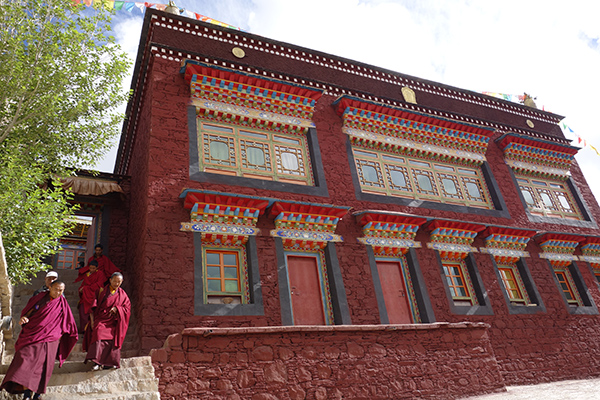
Monks walk past the recently renovated main sanctuary at the Ling bu Monastery in Gyangze county, Tibet.[Photo/China Daily]
The Palcho Monastery, the main Buddhist establishment in Gyangze county in the southwest of the Tibet autonomous region, is famous for its stunning architecture and large numbers of religious murals.
An enshrined Buddha and the murals demonstrate the narratives of three different schools of Tibetan Buddhism-the Gelukpa, the Sakya and the Nyingma-which have co-existed harmoniously for hundreds of years within the monastery’s walls.
-U106638386480yG-U101340614841c0C-600x400@English.gov.cn.jpg)
[Photo/China Daily]
The most famous architectural feature is the Kumbum, also known as “The 100,000 Buddha Pagoda”, which contains about 100,000 images and murals depicting the Buddha.
The Kumbum and its murals were largely destroyed in the early 20th century when British troops invaded Gyangze, and were later damaged during the “cultural revolution” (1966-76).
Now, they are being restored thanks to funding provided by the central and local governments, which invested about 110 million yuan ($17 million) during the 12th Five-Year Plan (2011-15), according to Jamyang Chophel, a high-ranking monk at the monastery.
“The majority of the monastery’s income comes from admission tickets and donations from pilgrims. The government is paying for the renovation of the historic relics,” he said.
The monastery is one of 4,277 registered cultural relic sites in the region, and 55 of them listed as national historic relics.
-U106638386480yG-U101340614841E8G-600x400@English.gov.cn.jpg)
[Photo/China Daily]
In recent years, the central government has increased investment in the preservation process, and 380 million yuan was spent between 2001 and 2005. The figure rose to 570 million yuan in the following five years, before jumping to more than 1 billion yuan between 2011 and this year.
In addition to government subsidies, most monasteries in Tibet are allowed to keep the income they earn from tourist admissions, providing they use the money to subsidize restoration and preservation of ancient relics.
Tashihunpo Monastery, in Xigaze, is home to 800 monks. It’s one of the most-important monasteries in the Gelukpa School of Tibetan Buddhism, and also the traditional seat of the Panchen Lama.
Atan, who leads the monastery’s cultural relics preservation team, said 30 percent of the income from its 80 yuan entrance fee is directed toward preservation, and the rising number of tourists mean the sums set aside are constantly increasing, he said.
During the 11th Five-Year Plan (2005-10), the government invested 12.3 million yuan on protecting and renovating the monastery’s relics, he said.
The monks also play an important role. For example, the historic relics preservation team at the Tashihunpo Monastery is composed of seven monks, while a further 270 are charged with daily maintenance of the assembly halls, he said.
